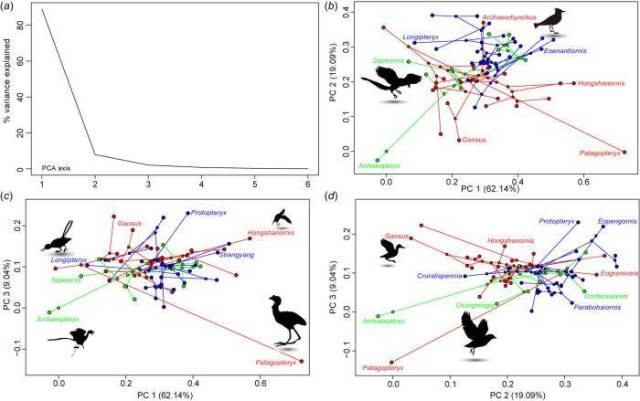The authoritative American scientific journal "Science" published on December 8, 2000 will publish a scientific research paper by Zhang Fucheng and Zhou Zhonghe, young scientists from the Institute of Vertebrate Paleontology and Paleoanthropology, Chinese Academy of Sciences, reporting on their discovery of the most primitive animal in the world to date. The anti-bird - proto-feather bird. The fossils of Protopteryx contain a previously unknown type of feathers that provide important evidence for the early evolution of feathers.

Feathers have always been considered a unique structure of birds and a symbol that distinguishes birds from all other vertebrates. But the scientific community has little understanding of the origin of bird feathers in the past. The only one is that "the feathers of birds and the scales of reptiles are homologous" or "feathers originate from reptiles." In recent years, the discovery of hairy dinosaurs in the western Liaoning region of my country has made the origin of feathers a hot topic in the paleontological community and one of the topics of public concern.
Archaeopteryx is recognized as the most primitive bird, but it does not provide much information on the origin of feathers because its feathers are almost completely different from those of modern birds.
The characteristics of the skin derivatives growing on the bodies of hairy dinosaurs such as Sinosauropteryx, Beipiaoosaurus, Sinornithosaurus and Microraptor are very similar to bird feathers, so the hairs on these small theropod dinosaurs are very similar. Easily thought of as a primitive feather. But the hairs on the species that linked dinosaurs to birds did not establish more connections between bird feathers and reptile scales. On the one hand, no branched structures have been found on the hairs of these dinosaurs so far, because they cannot be directly connected to the branched feathers of birds; on the other hand, these hairs are also difficult to associate with crawling animals. The animal's scales establish a direct connection.
The feathers of Caudopteryx and Protoarcheopteryx discovered not long ago were once considered to be the strongest evidence for the existence of feathers in dinosaurs. However, some scientists believe that Caudopteryx is a secondary vestigial bird, and its feathers are therefore also secondary. A vestigial type rather than representing primitive feathers. Since Caudopteryx is generally considered to be closely related to Oviraptorosaurus, and its systematic relationship with birds is not as close as that of Sinornithosaurus, which is a dromaeosaur, its feathers are considered to be more likely to have occurred independently, or perhaps Degenerative and therefore not directly related to the origin of bird feathers.
The long-squamates discovered by scientists in Central Asia had elongated scales. The similarity between these scales and the feathers of modern birds suggests that the early stages of bird feather evolution were much more complex than previously thought. Feathers may have begun to appear in reptiles that were more primitive than dinosaurs.
The newly discovered proto-feather bird fossil this time shows a new type of feathers that has never been found before. It lacks barb-like branching structures at one end of the body (called the proximal end), and there are feathers on both sides of the shaft. There is a homogeneous pinna structure, which is very similar to the scales of reptiles; the end far away from the body (called the distal end) differentiates into barbules, but there is also a proximal connection between the barbules and the rachis. It has the same homogeneous pinnae structure, which is exactly the same as the feather structure of modern birds. This skin derivative, which resembles both reptile scales and typical bird feathers, directly links reptile scales to bird feathers.
Mainly based on the research on this special type of feathers, Zhang Fucheng and Zhou Zhonghe proposed a model of early bird feather evolution, that is, the evolution of bird feathers mainly went through four stages: 1) Extended scales; 2) Increased length in the middle of the scales. Thick, feather rachis appears; 3) Differentiation of barbules; 4) Structures such as barbules and barbules grow, eventually forming the typical feathers of modern birds. In addition, another important argument of Zhang Fucheng and Zhou Zhonghe is that profile feathers and down feathers quickly differentiated in the early evolutionary stages of feathers, and then evolved independently to this day.
Through morphological research and systematic analysis of Protopteryx, Zhang Fucheng and Zhou Zhonghe also discovered that Protopteryx is the most primitive enantiornithine to date. Enantiornithes were the most important group of birds in the Mesozoic Era. They were once widely distributed around the world, but later became extinct. Protopteryx itself is also a specialized type. One of the most obvious manifestations is that the hand bones and small wing fingers are relatively long. This is very similar to Archaeopteryx and Confuciusornis, but different from other enantiornithes. Obviously, Protopteryx is an intermediate type between Archaeopteryx and other more advanced birds.
The structure of the protocoracoid bone on the chest of Protopteryx shows some characteristics of the precoracoid process. It is speculated that it is also the earliest bird with a precoracoid process discovered so far. The fossil bird has a precoracoid process. The appearance of the protrusion and the associated three-bone hole structure indicate for the first time that proto-featherbirds already had powerful active flight capabilities.
Another important feature of Protopteryx is the preservation of the flight structure of small wing feathers, which has not yet appeared in Archaeopteryx and Confuciusornis. Small wing feathers are the structural basis for modern birds to fly slowly and perform aerial tricks. They play an important role in the birds' takeoff, hovering and landing.
animal tags: Protopteryx Archaeopteryx Sinosaurus Beipiaoosaurus Sinornithosaurus Microraptor
We created this article in conjunction with AI technology, then made sure it was fact-checked and edited by a Animals Top editor.